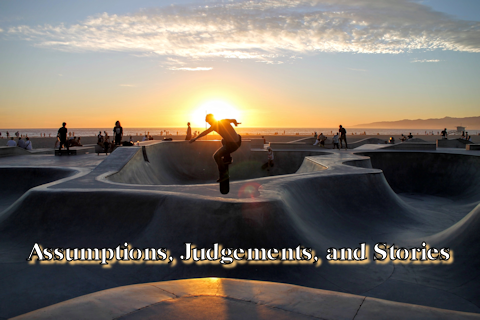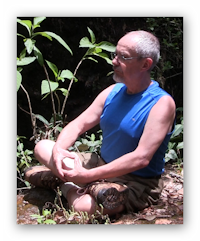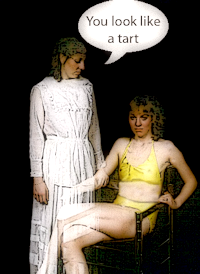Assumptions, Judgements, and Stories
Synopsis–Assumptions, Judgements, and Stories are always figments of our imagination. Learn how to let them go

I’ll spare you the “assumptions” cliche–and just begin by saying that we really ought to get over the whole assumption thing. But boy, is that is difficult.
It’s a biological thing. We’re hard-wired to be cautious.
We just started watching the first season of “Zoo” on Netflix, and the idea is that the animals of the world team up and start attacking. The people have a hard time believing that, say, house cats, are suddenly a threat. Because, assumptions.
The Zen approach to life is to notice the workings of the mind, and nothing is more interesting than watching the endless stream of assumptions, judgements, and stories. Which is a big step, as most of that stuff goes unnoticed.
The stream of non-consciousness is endless, and remains endless.

Lots of people tell me that they can’t meditate, and the reason they give is, “I can’t stop my mind.” As in, they think that in order to be a “successful” meditator, their mind needs to be silent. A total impossibility, but a popular thought.
The best one can hope for, and this is pretty easy to accomplish, is to get really good at watching the internal game. But the key is observing, while not getting hooked.
In other words, to see the stream, but not swim in it.
I suspect that the best way to learn to examine your assumptions is to meditate on them, no matter what you think about your meditative abilities. You need to figure out how to sit still, so either ask a meditation teacher, or go have a look at the online movie I created a few years back.
Learn to Meditate — a video describing how to sit.
If you can’t see the video, click here
Next, set an intention. Part of the intention is how long you will sit; I’d suggest 15 minutes minimum, and preferably 30. Once that’s decided, and you’ve picked a way to sit, then do so.
Breathe a bit to settle yourself, and then, in your head, tell yourself that you’re going to do some internal theatre movie watching. As soon as you do so, something will cross your mind. Literally, actually.
In Zen, thoughts are described as being like clouds drifting across a clear, blue sky. The meditative practice is “simple”; just watch each one drift across the sky that is your mind.
Now, reality will set in, and a thought will arise that interests you.
Zoom. Attachment. Which takes several forms, but in general is you, caught. You’ll find yourself talking to yourself, internally, or generating images, or feelings. You’ll “feel hard done by,” or angry, or sad, or happy, or horny, depending on the “cloud.”
In the normal meditative process, the you notice what you have grabbed on to, you have a breath, and to let go. Which, of course, leads to the arising of the next cloud, which you will either latch on to, or not.
One of our meditation teachers taught us to “count breaths.” Basically, inhale, rest, exhale, think “one.” Repeat. When you attach, or have a thought, you start back at “one.” You count up to 20.
The teacher said that she had been meditating for 25 years, and once or twice had gotten to 10. Best thing anyone ever told me.
Plainly, this is not easy, if by easy we mean “no thoughts.” As our teacher said, (and I’d note she was a Zen “monk,” and lived in a Zen community–meaning she meditated for long stretches several times a day) she’d occasionally made it to 10.
So, no thoughts is not the intention.
The intention is two-fold. 1) Noticing when you attach, and 2) choosing to let go.
So, at the end of your “sit,” say 5 minutes before, go ahead and attach to a cloud. But take a step back, and just watch yourself attaching. Notice what comes up. It will be the stuff I mentioned above: assumptions, judgements, and stories. Just watch and listen. In other words, don’t bite.

Usually, we have the “it’s not fair!” reaction (among others) and we’re off to the races. Blame, anger, righteousness, flowing. So, in this practice, the attempt is to stop short of involvement.
By this I mean, we might think “not fair.” Great. Now stop. Ask yourself, “What else?” In other words, instead of catching yourself in the first thing that comes up, just make a list. If you do this, you’ll find a list of your assumptions about the thought, but the list will lack power.
This is what we want to learn to do.
Then, after 5 minutes, still yourself, breathe, and end your meditation session.
Now, the reason we do all of this is not to be good on a mat. It’s to be present for life itself. Needless to say, this “assumptions, judgements, and stories” crap is going on, all the time. We want to stop ourselves from getting caught up in it, and one way to do that is to do what we just learned.
We learn to be able to do this any time, anywhere.
This morning, two guys were talking. I was on the rancho, and couldn’t hear their words. I noticed that, despite not having a clue, I was making up stories about them. And I was making myself tight, and a little angry. Over two guys. And a conversation I was not a part of, and couldn’t hear.
So, I did the above. Had a breath. Asked myself to tell myself what stories and judgements, what assumptions I was making. As I made a list, I could see how silly I was being. I was up in my head, the principal actor, and I was playing both of the guys, putting words in their mouths, attributing meaning to their conversation.
With no actual data to go on!
As I saw myself winding myself up, I chose to have a breath, turn my attention elsewhere, and enjoy the beautiful day.
Our assumptions, even about ourselves, are unreal, and not “so.” They are inventions designed to get a rise out of us, so that we feel alive.
The solution? Real life, as an awake participant, as we let go of assumptions, judgements, and stories.
The post Assumptions, Judgements, and Stories appeared first on The Pathless Path.



